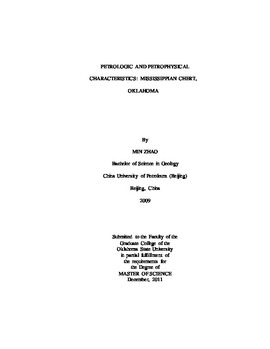| dc.description.abstract | The Mississippian chert has been explored and developed for more than 80 years as an important significant oil and gas reservoir. However, the origin of silica is poorly understood, its petrologic and petrophysical characteristics rarely discussed, and the formation of the chert debated. In this study, cores containing the Mississippian chert and Mississippian cherty limestones were described, sampled and analyzed. Core analysis included determination of grain types and textures, morphology of cherts, ratio of chert to matrix, relative density, and porosity types. Further information regarding petrophysical properties were acquired by analysis of well logs and measurement of porosity, permeability and density on core plugs. In particular, well logs across these intervals were examined to determine variations in gamma ray, spontaneous potential, resistivity, density and neutron porosity, and bulk density. Thin-sections were examined to determine mineral composition, pore types, confirm the possible sources of silica, and determine the relationship between cherts and limestones. The abundance of silica in the Mississippian limestone is closely linked to the abundance of spicules, evidence that the chert is mostly biogenic. Dissolution of sponge spicules is an important source of silica in the Mississippian chert, and the Mississippian cherty limestone. Diagenetic processes that altered the Mississippian chert involved multiple episodes of dissolution and silicification. Secondary porosity is dominant in the Mississippian chert. Porosity is formed by dissolution of chert matrix, clasts and spicules as well as fracturing. The highly silicified chert has a slightly lower rock density than Mississippian cherty limestone, because the latter has higher calcite content. Bulk density measurements from core plugs and well logs are closest in the tight rock, and most different in the high porosity zones. The upper and lower tripolitic chert are most favorable reservoirs, according to their high porosity and permeability. Also, tripolitic chert is very clean and contains abundant microporosity that affects wireline log signature. | |
